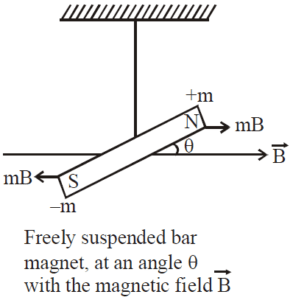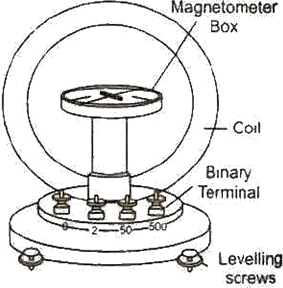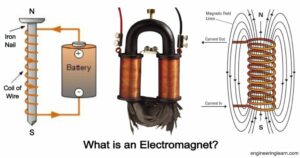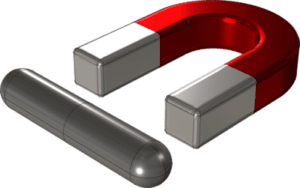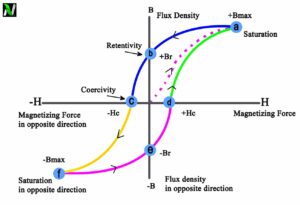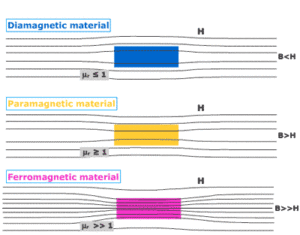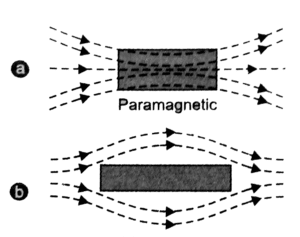There are various types of magnetism in nature viz. paramagnetism, diamagnetism, ferrimagnetism, etc, among these, ferromagnetism is the strongest one. Ferromagnetic materials are materials that exhibit instant net magnetization at the atomic level even in the absence of an external magnetic field.
When a ferromagnetic material is placed in an external magnetic field, they are strongly magnetized in the direction of the magnetic field. Ferromagnetic materials are strongly attracted towards the magnets.
In this article, we are going to learn about ferromagnetic materials- their definition, causes, properties, and applications, so let’s get started.
Read Also
What are Ferromagnetic Materials?
Definition: The ferromagnetic materials are those materials that exhibit strong magnetism in the same direction as that of the applied magnetic field.
Such materials have great tendency to move from a region of weak magnetic field to the region of strong magnetic field, i.e., they are strongly attracted towards the magnets.

Ferromagnetism is an uncommon property. It does not occur in all substances. The range of occurrence of this magnetism is very small i.e., it only occurs in a few materials. The most common ferromagnets are the transition metals such as iron, nickel, cobalt, and their alloys and the alloys of rare earth metals. The property of ferromagnetism is not only of the chemical composition of the material but also of its crystalline structure and microstructure of the materials.
In the case of iron and its relatives, the ferromagnetic behavior is shown by these materials is due to the presence of many unpaired electrons in their d-block, or in the case of rare-earth metals, the ferromagnetic behavior is shown by these materials is due to the presence of unpaired electrons in their the f-block orbitals, is a result of Hund’s rule of maximum multiplicity.
These are ferromagnetic metal alloys whose constituents are not themselves ferromagnetic, called Heusler alloys, named after Fritz Heusler. Conversely, there are non-magnetic alloys, such as stainless steel types, which are composed almost exclusively of ferromagnetic metals.
Heusler alloys: It is ferromagnetic metal alloys whose constituents are not themselves ferromagnetic.
Amorphous (means, non-crystalline) ferromagnetic metallic alloys can be made by very rapid cooling of a liquid alloy called quenching. These types of amorphous ferromagnetic metallic alloys have the advantage that their properties are nearly isotropic in nature (not aligned along a crystal axis). Due to this, it results in low coercivity, low hysteresis loss, high permeability, and high electrical resistivity.
One such typical material is a metalloid transition metal alloy, which consists of about 80% transition metal (usually Fe, Co, or Ni) and a metalloid component that lowers the melting point (B, C, Si, P, or Al).
What causes ferromagnetism?
Ferromagnetic materials have tiny magnets called domains. Actually, it is a tiny area in ferromagnetic materials with a specific overall spin orientation due to the quantum mechanical effect. In simple words, the atoms in the ferromagnetic materials possess a dipole moment that aligned in a specific direction over a microscopic volume called domains. Each domain has a net magnetization. When we apply an external magnetic field, the domains orient themselves in the direction of the applied in the magnetic field and simultaneously domains grow in size.[latexpage]
So here rise a question Why do these atomic dipole moments align in a specific direction?. The alignment of these atomic dipole moments is due to the exchange interaction.
Read Also
- Origin of ferromagnetism class 12: Domain theory
- Origin of paramagnetism class 12
- Origin of diamagnetism class 12
Exchange Interaction: It is the phenomenon by which individual atomic magnetic moments will attempt to align all other atomic magnetic moments of material with itself is known as the exchange interaction. If the magnetic moments line up parallel, the material is ferromagnetic, but if the magnetic moments are aligned antiparallel, the material is antiferromagnetic.
Materials in which the exchange interaction is much stronger than the competing dipole-dipole interaction are often referred to as magnetic materials. For example, iron (Fe) has the exchange force of about 1000 times stronger than the dipole interaction. Therefore, below the Curie temperature, virtually all dipoles in a ferromagnetic material are aligned in a specific direction.
Besides ferromagnetism, the exchange interaction is also responsible for the other types of the spontaneous ordering of atomic magnetic moments that occur in magnetic solids, antiferromagnetic, and ferrimagnetism. There are various exchange interaction mechanisms that produce magnetism in various ferromagnetic, ferrimagnetic, and antiferromagnetic substances. These mechanisms include Direct exchange, RKKY exchange, Double exchange, and Super exchange.
When two nearby atoms have unpaired electrons, they will interact with each other between two atoms and they line up themselves in a tiny region with the direction of the magnetic field, see figure below. This mechanism of the ferromagnetic material is called ferromagnetism. It can be defined as some materials (cobalt, gadolinium, iron, etc) that will become permanent magnets with the use of a magnetic field.

Properties of ferromagnetic materials
Ferromagnetic materials exhibit properties similar to that of paramagnetic materials but in a highly dominant manner. Some important properties of ferromagnetic materials are given below:
- When ferromagnetic materials is placed in external magnetic field, it develops a strong magnetization in the direction of the applied magnetic field.
- When ferromagnetic materials is placed in external magnetic field, the magnetic lines of force concentrate greatly into the material so that the magnetic induction B becomes much more than the magnetising field B0.
- When ferromagnetic materials is placed in non-uniform magnetic field, It tends to move from weaker to the stronger part of the magnetic fields.
- When rod of ferromagnetic materials is suspended freely in a uniform magnetic field, it quickly align itself parallel to the magnetic field.
- The intensity of magnetization M is proportional to the magnetising field intensity H for its smaller values. For moderate value of H, M increases rapidly and then finally attend constant value for large value of H. This indicates the attainment of the saturation stage of magnetization.
- The susceptibility of a ferromagnetic material has large positve value. This is because; $$\chi_m = \frac{M}{H}$$ and M>>H for a ferromagnetic matertial. It is of order of several thousands.
- The relative permeability $(\mu_r =1+\chi_m)$ of a ferromagnetic materials has large positive value. It is of the order of several thousands. For Iron, relative permeability is, $\mu_r =1000$.
- The susceptibility of ferromagnetic materials decreases with temperature in accordance with Curie-weiss Law: $$\chi_m =\frac{C}{T-T_C}\qquad [T>T_C]$$
- At a certain temperature called Curie point or Curie temperature, the susceptibility suddenly falls and ferromagnetic materials becomes paramagnet.
- The magnetisation is not only depends on the value of magnetising field but also on the past magnetic and mechanical history of the materials.
- And a most important property, All ferromagnetic materials can retains magnetism even after the removing of magnetising field.
Advantages of ferromagnetic materials
Some advantages of Ferromagnetic materials are given below:
- Resistance is high
- It is Cheap
- Hysteresis loss is low
- Electrical resistivity is high
- Coercivity is low
- It has High magnetic permeability
- It can operate up to 3000C temperature
- Stability of ferromagnetic materials are good
Applications of ferromagnetic materials
Some applications of the ferromagnetic materials are given below:
- Transformers
- Magnetic Storage
- It is used to build large Electromagnets
- Magnetic tape recording
- Hard drives
- Generators
- Telephones
- It is used in Loudspeakers
- Electric motors
- Hard disk

